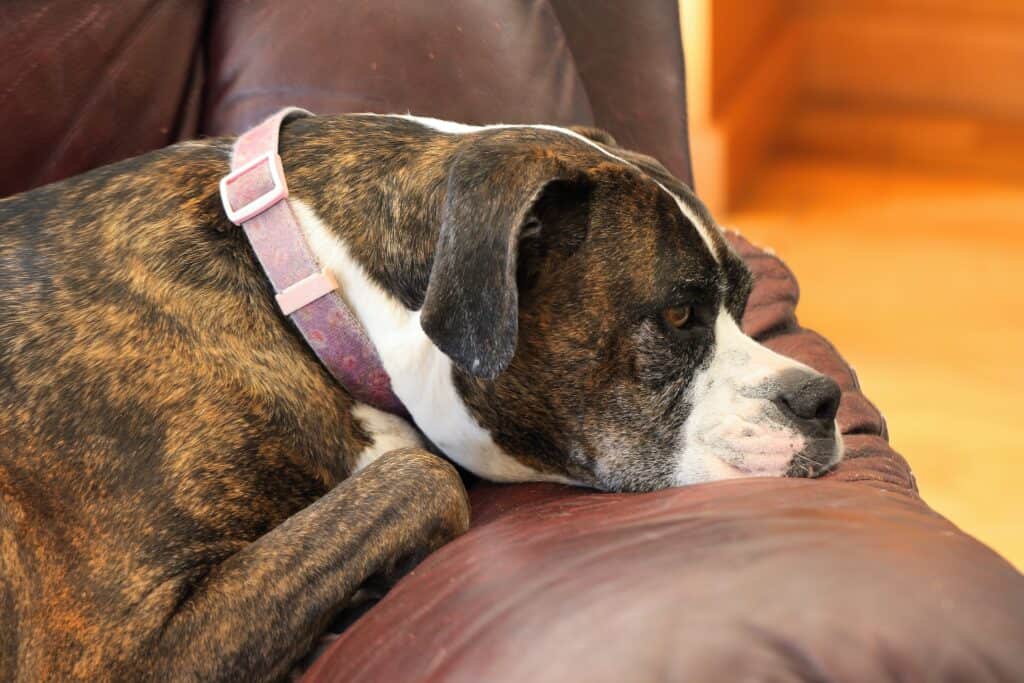Comprehension, avoidance, and management of anxiety and fear in dogs
Dogs, like humans, undergo moments of anxiety which is a common and beneficial emotion. All breeds can experience dog anxiety and fear, but the severity may vary from one dog to another. However, if anxiety levels become excessive and not addressed, it could lead to an anxiety disorder that can be detrimental to the dog’s behaviour and overall well-being. Ignoring dog anxiety can result in other issues that may arise.
Discovering whether your dog experiences anxiety and finding the best methods to treat it can be challenging. Fortunately, we are here to provide you with comprehensive insights on dog anxiety, including the usual triggers, symptoms, and remedies. Furthermore, we will disclose the best measures to prevent anxiety in dogs. In this way, you, as a responsible dog owner, will be able to appropriately address your pet’s anxiety.
Causes of Anxiety In Dogs
Fear : Loud noises, unfamiliar people or animals, hats or umbrellas, new surroundings, certain situations (such as visiting the pet store or riding in a car), and certain surfaces like grass or wood floors can all trigger fear-related anxiety in dogs. While some dogs may only have short-term responses to these stimuli, they can have a greater impact on anxious dogs.
Separation : Around 14 percent of dogs are estimated to be affected by separation anxiety, which can cause them to be unable to find comfort when left alone or separated from their family members. This anxiety can result in undesirable behaviors such as urinating or defecating inside the house, destroying furniture and furnishings, and excessive barking.
Aging : Anxiety related to age impacts senior dogs and is often linked with cognitive dysfunction syndrome (CDS). In dogs affected by CDS, decline in memory, learning, perception, and awareness occurs, similar to the initial stages of Alzheimer’s disease in humans. This results in confusion and anxiety among senior dogs, which is quite reasonable.

What are symptoms of anxiety in dogs?
To identify if your dog has anxiety, it is crucial to observe these various significant symptoms as signs of dog anxiety :
- Aggression
- Urinating or defecating In the house
- Repetitive or compulsive behaviours
- Restlessness
- Pacing
- Depression
- Destructive Behaviour
- Panting
- Drooling
Occasional anxiety-causing events may trigger some of these symptoms, but they can become recurrent and develop into more serious issues. The most perilous symptom of dog anxiety is aggression. This aggression can be targeted directly at people or other animals, or indirectly when a person gets in between the dog and the source of their aggression, such as another dog. Even if a dog is prevented from harming others, behaviors like growling or barking can lead to unpleasant situations for both humans and dogs.
A prevalent indication of separation anxiety in dogs is the act of urinating and defecating inside the house. Dogs experiencing anxiety tend to agitate themselves to a great extent, compelling them to relieve themselves indoors, despite being toilet-trained. Such behavior can be troublesome for pet owners, leading to property damage, and the cleanup process can be unpleasant.
Separation anxiety often leads to destructive behaviour, which generally occurs near entry and exit points such as doors and windows. Dogs in a state of heightened anxiety may also injure themselves while attempting to escape from crates, windows, or doors, resulting in costly veterinary treatments and painful injuries.

How can I help my dog with anxiety?
Counterconditioning : Owners can employ various training techniques to address dog anxiety, including counterconditioning. This approach aims to alter the dog’s reaction to anxiety-inducing stimuli by substituting undesirable behaviours such as aggression or anxiety with positive behaviours like sitting or paying attention to the owner.
Desensitization : Desensitization is an additional training approach that involves gradually acquainting the dog with the cause of its anxiety, ideally in small increments and with reduced intensity. Consistent exposure, combined with reinforcement of positive conduct, can effectively aid in anxiety management.
Medications used to treat anxiety in dogs
You may ask what can i give my dog for anxiety? In the event that your canine experiences a severe anxiety disorder, your veterinarian may advise the use of medications or natural remedies. Some commonly prescribed medications for anxiety in dogs include SSRIs and antidepressants like fluoxetine and clomipramine. For predictable anxiety-inducing situations such as thunderstorms, fireworks, or car rides, your veterinarian may prescribe a benzodiazepine along with an antidepressant to aid your dog in managing stress.
Selegiline, a drug commonly used to treat chronic anxiety in Europe, may also be beneficial for senior dogs with cognitive dysfunction syndrome. By reducing some of the symptoms associated with CDS, selegiline can provide relief for affected dogs.
Dogs with anxiety may find relief from natural therapies and products. Depending on the severity of the case, some products may be used alone, while others may be used in combination with medications. Natural products utilize pheromones and aromatherapy to lessen anxiety. It is recommended that you speak with your veterinarian to determine which natural products are best suited for your dog.
The utilization of CBD oil to alleviate anxiety in dogs
Reports of success in using CBD oil to treat dog anxiety have been made by some dog owners. CBD is a compound present in cannabis and hemp that is useful in treating various health conditions for both humans and dogs. According to anecdotal reports from dog owners, CBD oil can be an effective treatment for dog anxiety.
Although many people use CBD oil to treat anxiety, there is no scientific data on how it affects dogs. Additionally, CBD products are not regulated, so consistency and purity are not always verified. Therefore, if you plan to use CBD oil to treat your dog’s anxiety, it’s best to speak with a veterinarian. A veterinarian can help you determine if CBD oil is a suitable treatment for your dog’s anxiety, as well as discuss different products, potential side effects, and risks.
Preventing Anxiety in Dogs
Predicting the causes of anxiety in dogs can be challenging, and it can be even more challenging to ascertain if the anxiety will escalate into a severe disorder. Nonetheless, there are strategies to assist dogs or puppies in avoiding problems related to anxiety.
Body language : Learning to read dog body language is a highly beneficial activity to undertake. It allows you to identify when your dog is feeling uneasy or frightened, enabling you to steer clear of potentially unpleasant interactions or utilize them as opportunities for positive training. Additionally, being able to recognize body language cues can help you detect when your dog is becoming anxious, which is particularly advantageous if your dog has a background of anxiety-driven aggression.
Socialization : Preventing anxiety can be achieved through adequate socialization. Familiarizing your dog with new people, dogs, animals, places, and experiences can prevent an excessively intense reaction in the future, and additionally aids in the development of a well-adapted canine member of society.
Obedience : Training dogs to obey commands is a crucial technique for managing and preventing anxiety in dogs. This technique builds the basis for a healthy bond between the owner and the dog, establishing a foundation of trust. A disciplined dog is easier to introduce to other dogs, as compared to an untrained dog. Obedience classes provide a supervised environment for dogs to interact with other dogs, making it a great place for them to socialize.
Exercise & Nutrition : It is imperative to provide routine exercise and mental stimulation for your dog’s physical and mental growth and overall wellness. By engaging your dog’s mind, you can prevent harmful actions. Additionally, proper nutrition plays a significant role in maintaining your dog’s physical health. By addressing your dog’s needs, you can deter any behavioral issues not caused by anxiety and determine where your dog requires the most attention.
Situation Avoidence : In case your dog has been diagnosed with anxiety problems, it may help to steer clear of or prevent situations that trigger your dog’s anxiety. For instance, if you are aware that your dog gets anxious around big groups of canines, then it would be best to avoid dog parks. Avoiding such situations does not imply putting your life on hold, but it can alleviate some of the pressure on you and your dog.
Preventive measures such as leashes, body harnesses, and basket muzzles can be utilized to avoid dangerous situations if the source of anxiety cannot be avoided. Knowing your dog’s triggers will allow for advanced preparation in such situations.
The Main Point
It is common for dogs to experience anxiety just like humans do. While not all dogs may develop a diagnosed anxiety disorder, it is crucial to understand the reasons, signs, and treatment choices associated with dog anxiety. This knowledge can aid you as a pet owner in identifying the most effective ways to assist your dog in anxiety-provoking circumstances. If you suspect that your dog is experiencing anxiety, it is recommended that you seek advice from a veterinarian. A veterinarian can assess your dog’s condition, rule out any other health problems, and assist you in developing a treatment plan that is appropriate for your dog’s needs and your lifestyle.
A veterinarian might even suggest a certified behaviour trainer like Royal Companion Kennels. The one on one repetitive sessions can aid your dog build confidence with counterconditioning and desensitization from a professional.

